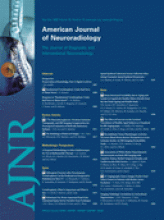Abstract
BACKGROUND AND PURPOSE: White matter (WM) hyperintensities on T2-weighted MR imaging are the most common imaging manifestation of neurotoxic effects of therapy for central nervous system (CNS) prophylaxis in childhood acute lymphoblastic leukemia (ALL). This study uses voxel-based analyses (VBA) of T2-weighted imaging of patients during treatment to identify which WM regions are preferentially damaged.
MATERIALS AND METHODS: Two sets of conventional T2-weighted axial images were acquired on a 1.5T MR imaging scanner from 197 consecutive patients (85 female, 112 male; aged 1.0–18.9 years) enrolled on an institutional ALL treatment protocol. Images were acquired after completion of induction therapy and after the final of the 4 courses of intravenous high-dose methotrexate in consolidation therapy (3.9 ± 0.8 months apart). Voxel-wise statistical testing of the incremental change between normalized longitudinal T2 images was performed with radiologist reading (normal or abnormal) and treatment risk-group as covariates.
RESULTS: Two highly significant bilateral clusters of T2 signal intensity change were identified in both 1-group and 2-group analyses. The regions were symmetric in size, shape, and average signal intensity. Increased T2-weighted signal intensity from these regions both within and between examinations were nonlinear functions of age at examination, and the difference between the examinations was greater for older subjects who received more intense therapy.
CONCLUSIONS: These analyses identified specific WM tracts involving predominantly the anterior, superior, and posterior corona radiata and superior longitudinal fasciculus, which were at increased risk for the development of T2-weighted hyperintensities during therapy for childhood ALL. These vulnerable regions may be the cause of subsequent cognitive difficulties consistently observed in survivors.
- Copyright © American Society of Neuroradiology
Indicates open access to non-subscribers at www.ajnr.org












